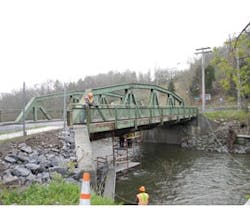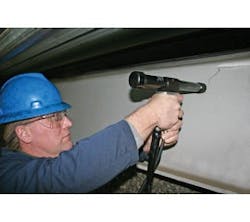BRIDGE RESCUE: No cracking up
Forgive those in charge of maintaining the nation’s steel bridges for thinking the sky is falling—they’re just trying to take advantage of the newest technology that could save their charges.
That technology, StopCrackEX, is based on a technique known as cold expansion, which traces its origins back to the aerospace industry in the mid-1960s. Pioneered by Boeing, cold expansion has worked its way through a number of industries over the last several decades before finding new purpose in the bridge industry.
The hole truth
Traditionally, engineers have used a method known as drill stops to halt a crack in a steel bridge. The concept is fairly simple: Repair workers find the end of the crack and drill a small hole just past the tip where the stress concentration is greatest, relieving the pressure and halting the crack’s progress.
The unfortunate reality, said Len Reid, vice president of technology at Fatigue Technology Inc. (FTI), is that drill stops turn out to be a temporary fix at best. “The problem is that the hole is not supported, and there are often little nicks and cracks around the hole itself; so as you apply cyclic tension loads, that’s just another stress concentration, so in effect all you’ve done is increased the length of the crack by the diameter of the hole,” he told Roads & Bridges. The rate of cracking may slow down for a few load cycles or even be fully arrested with light enough loads, but odds are it will reinitiate.
“I’ve seen pictures of bridges where they drilled a 7⁄8- to a 1-in.-diam. hole at the tip of these cracks, and then the crack would start to grow again so they’d drill another one. So some of these had five and six holes, one right after the other,” Reid said. In one or two cases, he even saw holes that were 2-3 in. in diameter, “which is just ludicrous.”
By inserting a metal bushing into a drill hole, residual compressive stress is created to counteract applied stress from future cyclic loads, effectively arresting the fatigue crack.
The key, then, is to counter that stress concentration, which is what cold expansion tries to do. Like with drill stops, a small hole is drilled just beyond the tip of a crack in the metal surface; for cold expansion, the hole is just 1⁄2 in. in diameter. Once the hole is made an interference fit fastener—whose diameter is actually larger than the hole—is driven inside, creating a pre-tensioned load and forcing the hole to expand.
Reid—who has been an engineer most of his life, including 25 years as an aerospace engineer with the Royal Australian Air Force and 27 and counting with FTI—was first exposed to cold-expansion technology while working on railroads. “Many train derailments are caused by fatigue cracks in the rail and bolt holes,” he explained. The U.S. DOT contacted Boeing about doing some testing and ultimately found cold expansion eliminated cracks around the bolt holes in rail joints, making it the standard for rail repair.
Hitting the road
According to Reid, FTI’s interest in cold expansion for bridges began when he was approached by a representative of the California Department of Transportation (Caltrans) during a conference in 2000. “They had an elevated roadway on a truss bridge over the Sacramento River, and they were getting cracks in the bolted joints under the roadway bed from the trucks and cars going over it,” he recalled. After a demonstration, the agency gave FTI the green light.
The company carried out extensive testing to see how cold expansion would impact a bridge structure already experiencing fatigue cracking. “We made some steel coupons and put a nick in the edge to create a naturally growing, 1⁄4-in. crack,” Reid explained. “I didn’t want to drill a smaller hole, so I went for a 1⁄2-in.-diam. hole.”
Even with cold expansion—and it’s “cold” only in the sense that high temperatures are not required for operation—the potential for renewal of a crack still exists. Reid wanted to use an interference fit fastener to expand the hole, “but sometimes you can’t get to the web of a steel bridge because they’re too big,” he said.
So instead, FTI developed a system that takes things one step further: An expansion mandrel is placed inside the drilled hole, encased in a lubricated sleeve, or bushing. The mandrel is pulled back out through the sleeve, which stretches the hole radially beyond its elastic limit. This creates residual compressive stress around the hole to combat the applied stress from cyclic loads. Reid compared the effect to a spring that’s been stretched beyond the point of elasticity so it won’t return to its original shape.
The test resulted in the ½-in.-diam. hole turning into a 1½-in.-diam. hole, with an extra inch of residual compressive stress. From there, FTI teamed with Los Angeles-based Miceli Infrastructure Consulting to conduct comparative testing between FTI’s system and traditional crack arrest holes. Cracking reinitiated past the open hole at around 250,000 cycles. With FTI’s system no new crack had formed after 20 million cycles.
“So then I started to increase the load on the coupon to see if I could carry even more load even if it had a crack in it,” Reid continued. “I found that I could increase the load by about 25% before the crack started to grow.”
Like with drill stops, a small hole should be made just past the tip of a fatigue crack when installing StopCrackEX.
Moving into action
Since that first application, success stories have come in abundance from around the country. Some of the highlights have included:
Manahawkin Bay Bridge, Stafford Township, N.J.
In October 2011, the New Jersey Department of Transportation (NJDOT) was looking to rehabilitate this 17-span structure, erected in 1959 and carrying Rte. 72 in Stafford Township. Routine inspections found fatigue cracks at numerous points along the structure, which were initially treated with conventional drill-stop methods utilizing 1-in.-diam. holes.
Delaware River Bridge, Margaretville, N.Y.
The New York State Department of Transportation (NYSDOT) found a 1.25-in. crack in a floorbeam of this small bridge in the eastern part of the state in early 2012. The bridge had previously been repaired in several locations due to flame damage and grooves, requiring additional bolting.
Skagit River Bridge, Burlington, Wash.
The most recent deployment of FTI’s system was enacted by the Washington State Department of Transportation (WSDOT) after part of the Skagit River Bridge collapsed in May 2013. Inspection of the remaining bridge spans revealed nearly 50 fatigue cracks peppered throughout the structure, and WSDOT needed a way to keep the bridge safe until it could eventually be replaced.
Reid said FTI also had done work with state DOTs in Missouri, Virginia, Nevada and Connecticut. In each case, the DOT purchased a kit from FTI with all of the bushings, tools and an instruction manual, and the agencies were able to implement the system themselves, making it a relatively low-cost solution.
And Reid hopes that as more and more agencies put the system to the test, it will better illustrate the benefits of cold expansion. “A lot of people, when you talk about it, are like, ‘What do you mean residual compressive stress?’ and all this stuff,” he said. “But when they try it, it’s pretty amazing.” R&B


